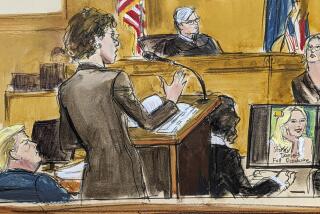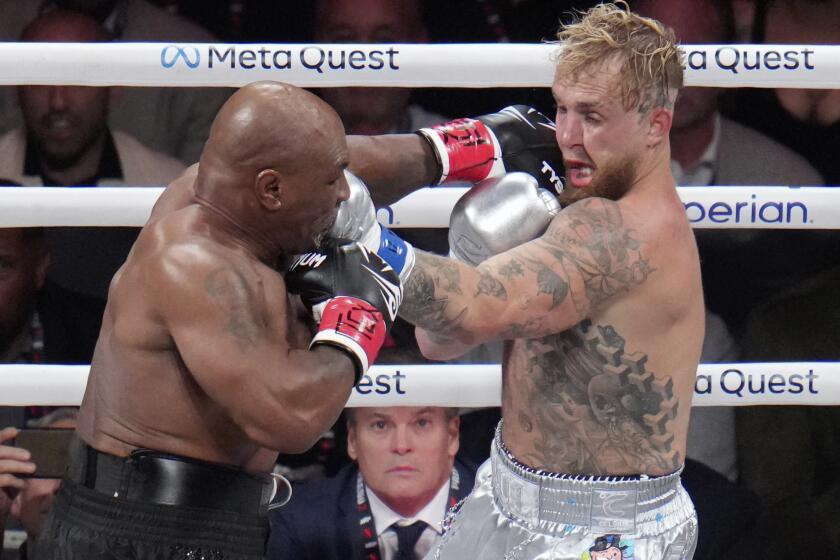A celebrity tossed in the slammer? That’s old news
Just as celebrity watchers swoon over the saga of socialite Paris Hilton, facing jail for driving with a suspended license, another glamorous traffic scofflaw received similar treatment 86 years ago.
And she did Hilton one better: She scored another movie role out of her time in the slammer.
For the record:
12:00 a.m. May 24, 2007 For The Record
Los Angeles Times Thursday May 24, 2007 Home Edition Main News Part A Page 2 National Desk 1 inches; 51 words Type of Material: Correction
Bebe Daniels: The L.A. Then and Now column in Sunday’s California section stated that silent screen star Bebe Daniels was 18 when she was jailed for speeding. She was 19 when she was ticketed in early January 1921, but she had turned 20 by the time she was sentenced in March.
For The Record
Los Angeles Times Sunday May 27, 2007 Home Edition Main News Part A Page 2 National Desk 1 inches; 49 words Type of Material: Correction
Bebe Daniels: The L.A. Then and Now column in the May 20 California section said silent screen star Bebe Daniels was 18 when she was jailed for speeding. She was 19 when ticketed in early January 1921 but had turned 20 by the time she was sentenced in March.
In March 1921, 18-year-old silent screen vamp Bebe Daniels drew a 10-day sentence for speeding through Santa Ana at 56.25 mph -- more than 20 mph over the limit. She was driving a Marmon Roadster, whose other Jazz Age owners included F. Scott Fitzgerald and his wife, Zelda.
Her arrest and trial touched off a comic legal circus and accorded Daniels the dubious honor of being the first woman convicted of speeding in Orange County. The events made the Saturday Evening Post and led to her starring in the comedy “The Speed Girl,” shot on location at the Romanesque courthouse where she was tried.
In January 1921, Daniels was behind the wheel of her high-powered speedster, racing through Santa Ana, when motorcycle officer Vernon “Shorty” Myers or Meyers -- his name was spelled both ways in news stories -- pulled her over. Daniels’ mother, Phyllis, was in the back seat. A friend, middleweight boxer Marty Farrell, rode shotgun, The Times reported. (Some reports said it was her boyfriend, heavyweight champ Jack Dempsey.)
Days later, spectators jammed a courtroom, waiting in vain for Daniels to appear. Her attorney, W.I. Gilbert, entered a plea of not guilty and demanded a change of venue based on “judicial prejudice.”
The justice of the peace, John Belshazzar Cox, denied the motion. He had never owned a car; he jailed everyone ticketed for driving more than 50 mph.
Cox, 76, had been a barber in Arkansas before moving to California. He won a seat on the bench in 1910 even though he was not a member of the bar.
Always available for interviews, he told The Times: “My office is never closed.” He often interrupted court proceedings to perform marriages -- 10,000 in all -- offering newlyweds this advice: “Get away from your mothers-in-law.”
Cox was a bit of a tippler, according to an official history of the Orange County Sheriff-Coroners Department. He was known to fall asleep during attorneys’ closing arguments.
But he seemed wide awake during the Daniels hearing. After listening to Gilbert argue that the court should show mercy to “this poor little girl who has been subjected to so much,” Cox set a trial date in March, two months away -- careful not to let it interfere with Daniels’ filming schedule.
As the disappointed crowd dispersed, Daniels and her friends swung by the courthouse to pick up Gilbert in the limo that had chauffeured them around town during the hearing. That one court date “cost her $2,000,” Gilbert told The Times.
Daniels was not one to spend the two months before trial playing the penitent. Weeks after the hearing, she appeared in a revealing gown at a benefit in Fullerton and sang “The Judge Cox Blues.”
Her brush with the law only enhanced her luster. Days before the trial, her publicity agent made sure all the Orange County theaters premiered her latest film, “She Couldn’t Help It,” an adaptation of the novel and play “In the Bishop’s Carriage.” In it, Daniels personified the brassier side of the good girl-bad girl theme.
On March 28, well before the trial’s 8 a.m. start, more than 1,500 spectators gathered outside the courthouse to get a glimpse of Daniels. She arrived fashionably dressed in a fur coat and a veiled hat.
During the two-hour jury selection, hundreds of Hollywood luminaries and locals wedged themselves into the courtroom. Daniels “appeared nervous ... [and] kept herself occupied by tugging at the skirt hem that enveloped her silken-clad ankles,” The Times reported.
As Daniels made her way to the witness stand, a bystander said, “Poor little thing, it will be a pity to send her to jail,” The Times reported. Another retorted, “She oughta get 10 years.”
The jurors were all elderly men -- mostly retired ranchers and a real estate agent. Daniels testified that her car had sprung a radiator leak and she had been dashing to a garage in San Juan Capistrano to have it repaired.
The motorcycle officer said that he’d caught Daniels in a “speed trap.” The speed limit was 35 mph.
Jurors didn’t buy Daniels’ excuse; they deliberated just seven minutes before convicting her.
When Cox pronounced sentence -- 10 days in Orange County Jail -- Daniels was unperturbed.
“I suppose if you live in a small town you get like that,” she said of Cox after the trial. “I bet 56.25 mph sounds awfully fast if you’ve never driven anything faster than a plow.”
She pronounced Cox “a nice, fatherly old gentleman,” promptly appealed and forked over $100 bail. (Her appeal failed.)
The Times caustically compared her bravado to Mary, Queen of Scots, on the scaffold, pointing out that after the trial, Daniels headed home eating peanuts in her limo. The car had refused to start; fans pushed it for two blocks until the motor sputtered to life.
When she reported to jail April 16 to begin her sentence, she was accompanied by an entourage, including her press agent, and such necessities as suitcases, hatboxes and chocolates.
Santa Ana residents strove to make her stay more pleasant, dropping by with boxes of oranges and lemons, a pair of slippers and a box of candy with her initials swirled on the top of each bonbon. A restaurant delivered three hot meals a day, including cream of asparagus soup, steak and strawberry shortcake. A furniture store installed an ivory-colored double bedroom set and rocking chair in her cell. A fan dropped off a Victrola phonograph and 150 records to while away those long, lonely days, while band leader Abe Lyman and his Cocoanut Grove orchestra serenaded at night below the window of her cell.
The first visitor to sign her guest book was Cox, who arrived with a dozen roses.
Daniels’ jailhouse guestbook eventually listed 792 names, including director Harold Lloyd. Comedian Roscoe “Fatty” Arbuckle sent her a telegram reading: “Houdini is in town. Can we help?”
(Months later, Arbuckle faced legal woes of his own, charged with rape and murder. He was acquitted, but the scandal undid his career.)
Daniels talked with locals, entertained visitors, answered fan mail and telegrams, and autographed boxes of candy, among other things. Although she had a cell to herself, 63 other female inmates, accused of such crimes as bootlegging, forgery, drunkenness, drug-dealing and bigamy, vied for her attention.
When she was released April 25, she vowed, “I’ll never speed again as long as I live.” She immediately started work on her next film, “The Speed Girl.”
*
More to Read
Go beyond the scoreboard
Get the latest on L.A.'s teams in the daily Sports Report newsletter.
You may occasionally receive promotional content from the Los Angeles Times.










